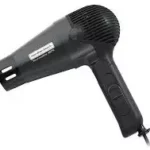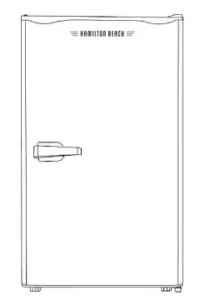
Hamilton Beach HBF3200-BLACK Compact Refrigerator Owner’s Manual
IMPORTANT SAFETY INFORMATION
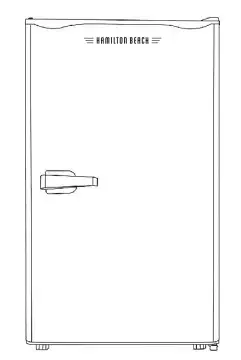 WARNING
WARNING
Please read all instructions before using this appliance.
 Safety Definitions
Safety Definitions
This is the safety alert symbol. It is used to alert of potential personal injury hazards. Obey all safety messages that follow this symbol to avoid possible injury =or death.
 DANGER
DANGER
DANGER indicates an imminently hazardous situation which, if not avoided, will result in death or serious injury.
 WARNING
WARNING
WARNING indicates a potentially hazardous situation which, if not avoided, could result in death or serious injury.
 CAUTION
CAUTION
CAUTION indicates a potentially hazardous situation which, if not avoided, may result in minor or moderate injury.
 IMPORTANT
IMPORTANT
IMPORTANT indicates installation, operation or maintenance information which is important but not hazard-related.
Child Safety
Destroy or recycle the carton, plastic bags, and any exterior wrapping material immediately after the refrigerator is unpacked. Children should NEVER use these items to play. Cartons covered with
rugs, bedspreads, plastic sheets or stretch wrap may become airtight chambers, and can quickly cause suffocation.
Safety Instructions
DO NOT store or use gasoline, or other flammable liquids in the vicinity of this or any other appliance. Read product labels for warnings regarding flammability and other hazards.
DO NOT operate the refrigerator in the presence of explosive fumes.
DO NOT store explosive substances such as aerosol cans with a flammable propellant in this appliance.Appliance shall not be exposed to rain. Remove all staples from the carton. Staples can cause severe cuts, and also destroy finishes if they come in contact with other appliances or furniture.
REFRIGERATOR SAFETY
Your safety and the safety of others are very important.
We have provided many important safety messages in this manual for your appliance. Always read and obey all safety messages.
 This is the Safety Alert Symbol. This symbol alerts you to potential hazards that can kill or injure you and others. All safety messages will follow the Safety
This is the Safety Alert Symbol. This symbol alerts you to potential hazards that can kill or injure you and others. All safety messages will follow the Safety
Alert Symbol and either the words” DANGER”, “WARNING” or “CAUTION”.
 Danger means that failure to heed this safety statement may result in severe personal injury or death
Danger means that failure to heed this safety statement may result in severe personal injury or death
 .Warning means that failure to heed this safety statement may result in extensive product damage, serious personal injury, or death.
.Warning means that failure to heed this safety statement may result in extensive product damage, serious personal injury, or death.
 Caution means that failure to heed this safety statement may result in minor or moderate personal injury, property or equipment damage.
Caution means that failure to heed this safety statement may result in minor or moderate personal injury, property or equipment damage.
All safety messages will alert to know what potential hazard is, tell you how to reduce the chance of injury, and let you know what can happen if the instructions are not followed.
IMPORTANT SAFEGUIDES
Before the refrigerator is used, it must be properly positioned and installed as described in this manual, so read the manual carefully. To reduce the risk of fire, electrical shock or injury when using the refrigerator, follow basic precaution, including the following:

- Plug into a grounded 3-prong outlet, do not remove grounding prong, do not use an adapter, and do not use an extension cord.
- Replace all panels before operating.
- It is recommended that a separate circuit, serving only your refrigerator be provided. Use receptacles that cannot be turned off by a switch or pull chain.
- Never clean refrigerator parts with flammable fluids. These fumes can create a fire hazard or explosion. And do not store or use gasoline or other flammable vapors and liquids in the vicinity of this or any other appliance. The fumes can create a fire hazard or explosion.
- Before proceeding with cleaning and maintenance operations, make sure the power cord of the unit is disconnected.
- Do not connect or disconnect the electric plug when your hands are wet.
- Unplug the refrigerator or disconnect power before cleaning or servicing. Failure to do so can result in electrical shock or death.
- Do not attempt to repair or replace any part of your refrigerator unless it is specifically recommended in this manual. All other servicing should be referred to a qualified technician.
 FOLLOW WARNING CALL OUTS BELOW ONLY WHEN APPLICABLE TO YOUR MODEL
FOLLOW WARNING CALL OUTS BELOW ONLY WHEN APPLICABLE TO YOUR MODEL
- Use two or more people to move and install the refrigerator. Failure to do so can result in back or other injury.
- To ensure proper ventilation for your refrigerator, the front of the unit must be completely unobstructed. Choose a well-ventilated area with temperatures above 60°F (16°C) and below 90°F (32°C). This unit must be installed in an area protected from the elements, such as wind, rain, water spray or drips.
- The refrigerator should not be located next to ovens, grills or other sources of high heat.
- The refrigerator must be installed with all electrical, water and drain connections in accordance with state and local codes. A standard electrical supply (115 V AC only, 60 Hz), properly grounded in accordance with the National Electrical Code and local codes and ordinances is required.
- Do not kink or pinch the power supply cord of the refrigerator.
- The fuse (or circuit breaker) size should be 15 amperes.
- It is important for the refrigerator to be leveled in order to work properly. You may need to make several adjustments to level it.
- All installation must be in accordance with local plumbing code requirements.
- Make certain that the pipes are not pinched or kinked or damaged during installation.
- Check for leaks after connection. • Never allow children to operate, play with or crawl inside the refrigerator.
- If you use the drainage container, you MUST set the Drain Select switch to OFF or the water can overflow from the drainage container.
- Although the unit has been tested at the factory, due to long-term transit and storage, the first batch of cubes must be discarded.
- Do not use solvent-based cleaning agents of abrasives on the interior. These cleaners may damage or discolor the interior.
- Do not use this apparatus for other than its intended purpose.
- This appliance is not intended for use by persons (including children) with reduced physical, sensory or mental capabilities, or lack of experience and knowledge, unless they have been given supervision or instruction concerning use of the appliance by a person responsible for their safety.
- WARNING—-Do not use mechanical devices or other means to accelerate the defrosting process, other than those recommended by the manufacturer.
- WARNING—-Do not damage the refrigerant circuit.
- WARNING—- Do not use electrical appliances inside the food storage compartments of the appliance, unless they are of the type recommended by the manufacturer.
REFRIGERANT GAS WARNINGS
DANGER – Risk of fire or explosion. Flammable refrigerant used.
DO NOT use mechanical devices to defrost refrigerator. DO NOT puncture refrigerant tubing.
DANGER – Risk of fire or explosion. Flammable refrigerant used.
To be repaired only by trained service personnel. DO NOT puncture refrigerant tubing.
CAUTION – Risk of fire or explosion. Flammable refrigerant used.
Consult repair manual/ owner’s guide before attempting to service
this product. All safety precautions must be followed.
CAUTION – Risk of fire or explosion. Dispose of properly in accordance with federal or local regulations. Flammable refrigerant used.
CAUTION – Risk of fire or explosion due to puncture of refrigerant tubing;
Follow handling instructions carefully. Flammable refrigerant used.
PARTS and FEATURES

- Door bins
- Door
- Thermostat
- Chiller compartment door
- Drip tray
- Removable shelf (big)
- Removable shelf (small)
- Leveling leg
- Front foot
IMPORTANT SAFETY INSTRUCTIONS
WARNING;¥
To reduce the risk of fire, electrical shock, or injury when using your appliance, follow these basic precautions:
- Read all instructions before using the refrigerator. DANGER or WARNING: Risk of child entrapment.
Child entrapment and suffocation are not problems of the past. Junked or
abandoned refrigerators are still dangerous … even if they will “just sit in the - garage a few days.” Before you throw away your old refrigerator: Take off the doors. Leave the
- shelves in place so that children may not easily climb inside. . Never allow children to operate, play with, or crawl inside the refrigerator. Never clean refrigerator parts with flammable fluids.The fumes can create a
- fire hazard or explosion. Do not store or use gasoline or any other flammable vapors and liquids in the vicinity of this or any other refrigerator. The fumes can create a fire hazard or explosion.
INSTALLATION INSTRUCTIONS
- Before Using Your Unit
- Remove the exterior and interior packaging.
- Check to be sure you have all of the following parts:
1 Water Drip Tray
1 Ice Cube Tray
1 Instruction Manual - Before connecting the unit to the power source, let it stand upright for approximately 2 hours.
This will reduce the possibility of a malfunction in the cooling system from handling during transportation - Clean the interior surface with lukewarm water using a soft cloth.
Installino Your Unit
- This appliance is designed to be free standing only, and should not be recessed or built-in.
- Place your unit on a floor that is strong enough to support the unit when it is fully loaded. To level your unit, adjust the leveling legs at the bottom of the unit.
- Allow 5 inches of space between the back and sides of the unit, which allows the proper air circulation to cool the compressor and condenser.
- Locate the unit away from direct sunlight and sources of heat (stove, heater, radiator, etc. Direct sunlight may affect the acrylic coating and heat sources may increase electrical consumption. Extreme cold ambient temperatures may also cause the unit not to perform properly.
- Avoid locating the unit in moist areas.
- Plug the unit into an exclusive, properly installed and grounded wall outlet. Do not under any circumstances cut or remove the third (ground) prong from the power cord. Any questions concerning power and/or grounding should be directed toward a certified electrician or the service center.
- After plugging the appliance into a wall outlet, allow the unit to cool down for 2-3 hours before placing food in the refrigerator and freezer compartments.
Electrical Connection
;¥’Warning;¥’
Improper use of the grounded plug can result in the risk of electrical shock. If the power cord is damaged, have it replaced by the service center.
This unit should be properly grounded for your safety. The power cord of this unit is equipped with a three-prong plug which mates with standard three prong wall outlets to minimize the possibility of electrical shock.
Do not under any circumstances cut or remove the third ground prong from the power cord supplied. For personal safety, this appliance must be properly grounded.
This unit requires a standard 115/120 Volt AC -/60Hz electrical outlet with three-prong ground.
Have the wall outlet and circuit checked by a qualified electrician to make sure the outlet is properly grounded. When a standard 2-prong wall outlet is encountered, it is your responsibility and obligation to have it replaced with a properly grounded 3-prong wall outlet.
The cord should be secured behind the unit and not left exposed or dangling to prevent accidental injury.
The unit should always be plugged into its own individual electrical outlet which has a voltage rating that matches the rating label on the appliance. This provides the best performance and also prevents overloading house wiring circuits that could cause a fire hazard due to overheating.
Never unplug the unit by pulling the power cord. Always grip the plug firmly and pull straight out from the receptacle. Repair or replace immediately all power cords that have become frayed or otherwise damaged. Do not use a cord that shows cracks or abrasion damage along its length or at either end. When moving the unit, be careful not to damage the power cord.
► Extension Cord
Because of potential safety hazards under certain conditions, it is strongly recommended that you do not use an extension cord with this unit. However, if you must use an extension cord it is
absolutely necessary that it be a UL/CUL-Listed, 3-wire grounding type appliance extension cord having a grounding type plug and outlet and that the electrical rating of the cord be 115 volts and at least 10 amperes.
► SURGE PROTECTOR
Most electrical appliances use a series of electric control boards to operate. These boards are very susceptible to power surges and could be damaged or destroyed. If the appliance is going to be used in an area or if your city/country is prone to power surges/outages; it is suggested that you use a power surge protector for all electrical devices/appliances you use. The surge protector that you select must have a surge block high enough to protect the appliance it is connected to. If you have any questions regarding the type and size of surge protector needed contact a licensed electrician in your area.
Damages due to power surges are not considered a manufacturer-covered defect and will void your product warranty.
► Reversing the Door Swing of Your Appliance
This appliance has the capability of the door opening from either the left or right side. The unit is delivered to you with the door opening from the left side.
Following refrigerator pictures are for your reference only.
OPERATING YOUR UNIT
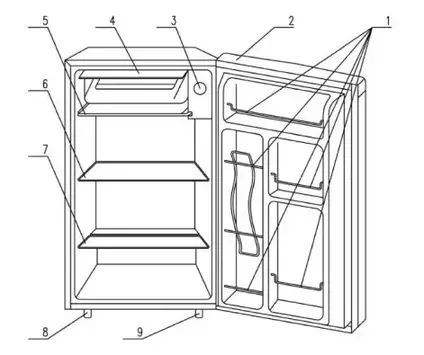
► Setting the Temperature Control
- Your unit has only one control for regulating the temperature in the compartment. The temperature control is located on the upper right hand side of the compartment.
- The first time you turn the unit on, set the temperature control to “5”.
- The range of the temperature control is from position “O” to “5”. After 24 to 48 hours, adjust the temperature control to the setting that best suites your needs. The setting of “3” should be appropriate for home or office use.
- To turn the appliance off, turn the temperature control to “O”.
NOTE:
- Turning the temperature control to “O” position stops the cooling cycle but does not shut off the power to the unit.
- If the unit is unplugged, has lost power, or is turned off, you must wait 3 to 5 minutes before restarting the unit. If you attempt to restart before this time delay, the unit will not start.
► Using Your Ice Cube Tray
- Recommended thermostat setting for ice-making is position 5.
- Fill the ice cube tray (two thirds of it) with cold water or with any liquid suitable for freezing and place the tray on the bottom of the chiller compartment to freeze properly.
- Dry the tray, otherwise it may stick to the bottom of the chiller.
- The best method to get ice cubes out of the tray is to hold the tray under cold tap water for a second.
- To eject the ice cubes from the tray, place over the ice bucket and twist slightly.
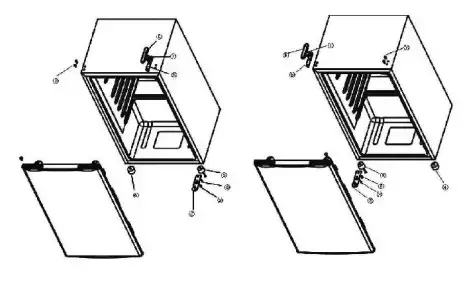
► The Chiller Compartment
- This compartment is designed for production of ice cubes and short-term storage (3-4 days at most) of some commercially frozen foods.
- The temperature in this compartment does not get cold enough to freeze food safely for long periods of time and works best when the food is already frozen.
- By design, this chiller compartment is not a true freezer, and may not keep ice cream frozen, or freeze items.
- A colder setting may be used for these items, but other items in the refrigerator may also be affected.
- The chiller door is susceptible to breaking due to excessive ice build up. This part is not covered under your warranty. Be sure to defrost when the ice reaches 1/4 inch thickness.
CARE AND MAINTENANCE
► Defrosting Your Unit
- Defrost the unit when the frost accumulated on the evaporator is about 5mm (1/5 inch) thick. Set the thermostat dial to “O” position.
- Remove frozen or perishable foods from the appliance and place it in a cooler to protect the food.
- During the defrost cycle, the ice melts into the water collection tray.
- To remove the water, either remove the water collection tray and/or place a collection container under the tray.
- Dry the water collection tray and place back under the appliance compartment.
- Defrosting usually takes a few hours. After defrosting, return the thermostat dial to the desired position. To defrost quickly remove all foods from the unit and leave the door open. Never use a knife or other metal instrument to scrape ice/frost from the evaporator.
► Cleaning Your Unit
- Turn the temperature control to “O”, unplug the unit, and remove the food, shelves, and trays.
- Wash the inside surfaces with a warm water and baking soda solution. The solution should be about 2 tablespoons of baking soda to a quart of water.
- Wash the shelves and trays with a mild detergent solution.
- The outside of the unit should be cleaned with mild detergent and warm water.
- Wring excess water out of the sponge or cloth before cleaning the area of the controls, or any electrical parts.
- Wash the outside cabinet with warm water and mild liquid detergent. Rinse well and wipe dry with a clean soft cloth.
CAUTION:
Failure to unplug the unit could result in electrical shock or personal injury.
CAUTION
Do not use boiling water because it may damage the plastic parts. In addition, never use a sharp or metallic instrument to remove frost as it may damage the cooling coils and will
void the warranty. We recommend using a plastic scraper.
- Use a sponge or towel to pick up the melting ice off the unitfloor.
- Remove the frozen food from the chiller compartment and place it in a cooler to protect the food.
► Power Failure
Most power failures are corrected within a few hours and should not affect the temperature of your unit if you minimize the number of times the door is opened. If the power is going to be
off for a longer period of time, you need to take the proper steps to protect your food
► Vacation Time
Short vacations: Leave the unit operating during vacations of less than three weeks.
Long vacations: If the appliance will not be used for several months, remove all food and unplug the power cord. Clean and dry the interior thoroughly. To prevent odor and mold growth, leave the door open slightly: blocking it open if necessary.
► Moving Your Unit
- Remove all the food.
- Securely tape down all loose items inside your unit.
- Turn the leveling screws up to the base to avoid damage.
- Tape the door shut.
- Be sure the unit stays secure in the upright position during transportation. Also protect the outside of the unit with a blanket, or similar item.
► Moving Your Unit
- Remove all the food.
- Securely tape down all loose items inside your unit.
- Turn the leveling screws up to the base to avoid damage.
- Tape the door shut.
- Be sure the unit stays secure in the upright position during transportation. Also protect the outside of the unit with a blanket, or similar item.
PROBLEMS WITH YOUR UNIT
You can solve many common unit problems easily, saving you the cost of a possible service call. Try the suggestions below to see if you can solve the problem before calling the servicer.
TROUBLESHOOTING GUIDE
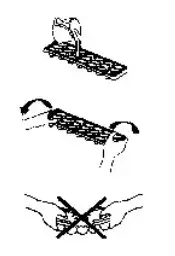
WIRING DIAGRAM
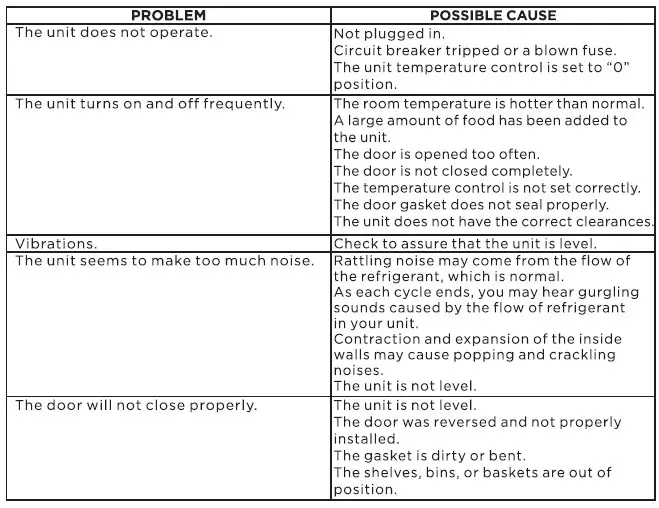
Voltage/ Frequency: 115V/60Hz
For service assistance and product information, please call: 1-800-968-9853. Curtis International Ltd.
7045 BECKETT DRIVE, UNIT 15, MISSISSAUGA, ON, L5S 2A3 www.curtisint.com
► Handle install instruction
- Take out the handle from the unit and remove the package of two handle parts and 2 screws.
- Use a screwdriver to secure the handle to the bottom of the door using the two screws.
- Push the handle horizontally until the handle is secure.
- Push and pull the handle to make sure the handle is installed well.
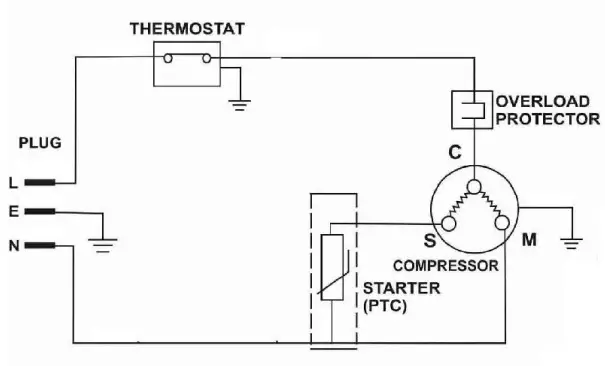
► Bottle Opener Assembly
- Remove the two Screws from the exterior of the refrigerator door using a Phillips-head screwdriver.
- Align the holes of the Bottle Opener with the holes on the refrigerator door. Secure the Bottle Opener to the door using the two Screws and screwdriver
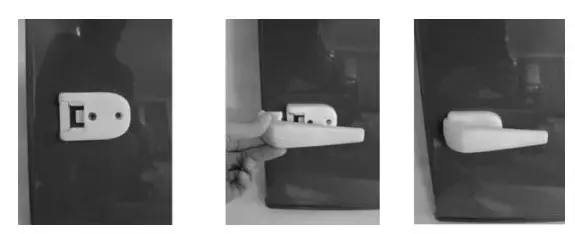
PRODUCT SPECIFICATIONS

WARNING – Keep ventilation openings, in the appliance enclosure or in the built-in structure, Clear of obstruction.
WARNING – Do not use mechanical devices or other means to accelerate the defrosting process, other than those recommended by the manufacturer.
WARNING – Do not damage the refrigerant circuit.
WARNING – Do not use electrical appliances inside the food storage compartments of the appliances, unless they are of the type recommended by the manufacturer.
DANGER: Risk of child entrapment. Before you throw away your old refrigerator or freezer:
- Take off the doors.
- Leave the shelves in place so that children may not easily climb inside.
LIMITED WARRANTY
To make a warranty claim, please email [email protected] or call 1-800-968-9853.
Year Warranty
This product is warranted to be free from defects in material and workmanship for a period of one (1) year from the date of original purchase. During this period, your exclusive remedy is repair or replacement of this product or component found to be defective, at our option; however, you are responsible for all costs associated with returning the product to us. If the product or component is no
longer available, we will replace with a similar one of equal or greater value. Prior to a replacement being sent, the product must be rendered inoperable or returned to us.
This warranty does not cover glass, filters, wear from normal use, use not in conformity with the printed directions., or damage to the product resulting from accident, alteration, abuse, or misuse.
This warranty extends only to the original consumer purchaser or gift recipient. Keep the original sales receipt, as proof of purchase is required to make a warranty claim. This warranty is void if the product
is used for other than single-family household use or subjected to any voltage and waveform other than as on the specified rating on the label (e.g., 120V-60Hz).
We exclude all claims for special, incidental, and consequential damages caused by breach of express or implied warranty. All liability is limited to the amount of the purchase price. Every implied warranty, including any statutory warranty or condition of merchantability or fitness for a particular purpose, is disclaimed except to the extent prohibited by law, in which case such warranty or condition is limited to the duration of this written warranty. This warranty gives you specific legal rights. You may have other legal rights that vary depending on where you live. Some states or provinces do not allow limitations on implied warranties or special, incidental, or consequential damages, so the foregoing limitations may not apply to you.
For faster service, locate the model, type, and serial numbers on your appliance.
ATTACH YOUR PROOF OF PURCHASE HERE, PROOF OF PURCHASE IS REQUIRED TO OBTAIN WARRANTY SERVICE.
Please have the following information available when you contact the Support Team:
- Name, address and telephone number.
- Model number and serial number.
- A clear, detailed description of the problem. Proof of purchase including dealer or retailer name, address and date of purchase
